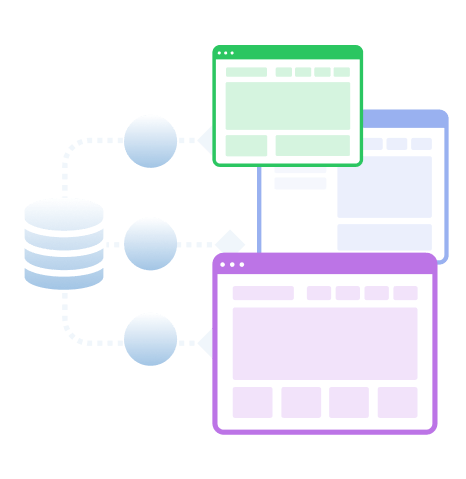Introduction
The concept of headless commerce marks a substantial transformation within the e-commerce realm. This approach encompasses the decoupling of the front-end presentation layer from the back-end operations, empowering e-commerce businesses to enhance flexibility and speed while managing their operational workflows.
This separation fosters heightened agility and the ability to create personalized experiences, ultimately enriching the user journey. In contrast to traditional e-commerce platforms, headless commerce solutions offer a framework that streamlines the integration of diverse technologies, thus paving the way for cutting-edge and engaging digital storefront experiences.
Understanding headless architecture
Headless commerce architectures are a software design approach in which the front-end and back-end of an application are completely decoupled and operate independently of each other. The front-end, which encompasses the user interface and user experience components, communicates with the back-end, where the business logic and data processing take place using APIs (Application Programming Interfaces).
This architectural approach allows businesses to select and utilize any front-end framework of their choice while ensuring that the back-end functions efficiently and reliably. By decoupling the front-end and back-end, businesses can take advantage of a flexible solution that can adapt to changing market trends and meet diverse business needs.

Benefits of headless commerce
The advantages of headless ecommerce are extensive and impactful. Firstly, headless commerce empowers e-commerce businesses to achieve unprecedented levels of customization for their user interfaces. This level of customization enables businesses to create unique and immersive customer experiences, which can set them apart from their competitors.
Secondly, a headless solution significantly improves site speed and performance by decoupling the front-end and back-end systems. This is made possible through the utilization of progressive web apps and other modern web technologies, ensuring that users have a fast, smooth, and enjoyable browsing and purchasing experience.
Furthermore, headless commerce solutions enable seamless integration with third-party services, leading to enhanced functionality and streamlined customer relationship management. This level of integration can provide businesses with the flexibility and capability to expand and optimize their operations in alignment with their unique needs and goals.
Implementing headless commerce
Implementing headless commerce offers businesses a flexible eCommerce solution that allows them to customize their technology stack, providing significant control over both front-end presentation and back-end systems. In order to implement a headless commerce solution, businesses must focus on adopting a headless content management system (CMS) and a robust back-end system that is capable of efficiently handling API requests. Transitioning from a traditional e-commerce model to a headless architecture involves a complex yet highly rewarding process.
It is crucial to have a dedicated development team to ensure the successful implementation of the headless commerce system. This team will be responsible for ensuring that both the front-end and back-end systems work seamlessly together, maximizing the benefits of the headless commerce approach.
Headless commerce platforms
A number of headless commerce platforms have entered the market, offering businesses a wide range of tools and services to construct customized storefronts. Leading platforms such as Adobe Commerce (previously known as Magento), BigCommerce, and Commercetools provide extensive solutions tailored to support headless architectures. These platforms empower businesses to develop dynamic, adaptable, and mobile-friendly online stores that can effectively meet the constantly evolving needs of the e-commerce sector.

Headless CMS and content management
In a headless commerce architecture, the role of a headless CMS is crucial for decoupling content management from the presentation layer. This separation provides the flexibility to manage and distribute content independently across various digital channels, including websites, mobile apps, and social media platforms.
By detaching content from its delivery mechanism, businesses can ensure a consistent, efficient, and tailored content delivery strategy, ultimately enhancing the overall user experience and maximizing the impact of their digital assets.
Traditional vs. headless commerce
Traditional and headless commerce platforms typically combine the front-end (what the customer sees) and the back-end (the underlying infrastructure), which can sometimes restrict flexibility and impede innovation. Traditional ecommerce, in particular, highlights these limitations and challenges for businesses seeking customization and agility.
On the other hand, headless commerce decouples these layers, allowing for more extensive customization and adaptability. This segregation empowers businesses to swiftly introduce new features, promptly adapt to market shifts, and deliver personalized customer experiences. The headless approach is especially advantageous for enterprises aiming to expand and innovate at a rapid pace.
Enhancing customer experience
One of the core objectives of headless commerce is to elevate the customer experience by decoupling the front-end presentation layer from the back-end commerce functionality. This allows businesses to craft custom user interfaces that cater to the specific needs and preferences of their customers, thereby fostering deeper engagement and interaction.
Through the adoption of a headless architecture, companies can seamlessly incorporate targeted marketing tools, in-depth analytics, and frictionless integration with external services, culminating in an enriched and personalized customer journey.

Headless commerce strategy
In order to develop an effective headless commerce strategy, businesses need to undertake a series of crucial steps. Firstly, they must conduct a comprehensive assessment of their existing ecommerce platform to pinpoint specific areas that require enhancement or modification.
After this, it is important to carefully choose a suitable headless platform and content management system (CMS) that are in accordance with the business’s objectives and aspirations.
Finally, crafting a detailed implementation plan, which includes a clear roadmap for transitioning from a traditional architecture to a headless one, is vital for ensuring the successful execution of the strategy.
The role of APIs in headless commerce
APIs play a critical role in headless commerce by serving as the conduit for communication between the front-end and back-end systems. They empower the seamless integration of a wide range of functionalities, including payment processing, inventory management, and customer relationship management, within the headless commerce framework. This integration is essential for ensuring that all components operate cohesively, resulting in an efficient and unified e-commerce solution.
Custom storefronts and user interface
By leveraging headless commerce, businesses can gain a significant advantage through the creation of custom storefronts. This approach allows companies to craft tailored user interfaces that not only align with their brand identity but also cater to the specific requirements of their customers.

The flexibility of customization extends beyond traditional web interfaces to encompass mobile apps, progressive web apps, and various other digital touchpoints. As a result, businesses can deliver a seamless and captivating user experience that remains consistent across all platforms, thereby enhancing customer engagement and loyalty.
Integrating third-party services
Headless commerce platforms play a crucial role in the seamless integration of a wide range of third-party services, thereby significantly enhancing the overall functionality and performance of e-commerce websites. These third-party services encompass an extensive array of tools and features, including but not limited to diversified payment gateways, advanced analytics tools, sophisticated marketing automation solutions, and more.

By effectively harnessing the power of these integrations, businesses can optimize and streamline their operations, gain deeper and more actionable insights into customer behavior, and ultimately provide highly tailored and personalized shopping experiences that resonate with their target audience on a more profound level.
Challenges of headless commerce implementation
Transitioning from traditional e-commerce platforms to a headless architecture offers numerous advantages, such as increased flexibility and the ability to deliver more personalized customer experiences. However, this transition also comes with its own set of challenges. The process of implementing headless commerce can be complex and time-consuming, requiring a substantial investment of resources.
Businesses must ensure that their development teams are well-versed in managing API integrations and capable of effectively maintaining both the front-end and back-end systems. Achieving a successful transition to a headless architecture involves careful planning and a comprehensive understanding of the technical requirements involved.
Future trends in headless commerce
The future of headless commerce is very promising, with several key trends currently driving its evolution. One significant trend is the adoption of progressive web apps (PWAs), which are revolutionizing the way consumers interact with e-commerce platforms. PWAs offer seamless, app-like experiences on mobile and desktop devices, enhancing user engagement and driving conversions.
In addition, the focus on enhancing mobile experiences is reshaping the landscape of headless commerce. As more consumers shift towards mobile devices for their online shopping needs, e-commerce businesses are leveraging innovative technologies and design principles to create optimized and intuitive mobile experiences that drive sales and customer loyalty.
Furthermore, the advancement of personalization techniques within the headless commerce framework is expected to play a crucial role in the future. Personalized shopping experiences, powered by data-driven insights and machine learning algorithms, enable e-commerce businesses to deliver tailored recommendations and content to individual users, thereby increasing customer satisfaction and driving revenue.
Moreover, the continuous development of APIs and headless CMS platforms is simplifying the implementation process for headless commerce and expanding the possibilities for e-commerce businesses. These advancements enable seamless integration with various front-end channels and empower businesses to deliver consistent and cohesive brand experiences across different touchpoints.
Overall, these transformative trends are shaping the future of headless commerce, paving the way for enhanced customer experiences and greater opportunities for e-commerce businesses to thrive in an increasingly digital marketplace.

Case studies of successful headless commerce implementations
Several e-commerce businesses have embraced headless commerce solutions with great success, showcasing the immense potential of this innovative approach. Major retailers, in particular, have harnessed the power of headless platforms to build online stores that offer unparalleled responsiveness and customization. This, in turn, has led to elevated levels of customer engagement and significantly improved conversion rates. The success stories of these businesses serve as compelling evidence of the substantial advantages associated with adopting a headless commerce strategy.
Headless commerce & Shopify
Shopify has embraced headless commerce by providing robust tools and APIs that allow merchants to build custom storefronts while leveraging Shopify’s powerful back-end capabilities. Shopify’s headless commerce solution gives businesses full creative control over their customer-facing experiences. Merchants can use third-party applications and frameworks to create unique front-end designs that are not possible with traditional, monolithic e-commerce platforms.
Shopify’s Storefront API and Hydrogen framework are key components of its headless commerce offering. The Storefront API allows developers to access Shopify’s commerce engine and integrate it with any front-end technology, providing the flexibility to create any shopping experience desired. Hydrogen, a React-based framework, simplifies the development of performant, custom storefronts and includes built-in Oxygen hosting for easy deployment.
Headless commerce with Shopify enables businesses to create unique and cohesive customer experiences across all channels, enhancing engagement and driving growth. By decoupling the front-end and back-end, merchants can innovate rapidly, optimize site performance, and integrate seamlessly with various third-party services, making it a powerful approach for modern e-commerce businesses.
Pandectes GDPR Compliance app supports headless commerce
The Pandectes GDPR Compliance app is a comprehensive solution designed to help Shopify merchants comply with GDPR, CCPA, and other privacy regulations. This app provides tools for managing cookie consent, data requests, and privacy policies, ensuring that businesses can maintain compliance and build trust with their customers.

The app is highly flexible and supports various e-commerce setups, including headless commerce. Merchants using external Shopify front-ends or headless commerce architectures can integrate the Pandectes GDPR Compliance app seamlessly. This is made possible through the app’s robust API, which allows for easy embedding and customization of consent banners and other compliance-related features on any front-end technology being used.
Pandectes offers extensive documentation and support to ensure smooth implementation across different platforms. The app includes customizable cookie consent banners, automatic blocking of non-essential cookies until consent is given, and comprehensive record-keeping to document user consent. Additionally, it provides features to handle data access and deletion requests, making it a one-stop solution for privacy compliance.
By using the Pandectes GDPR Compliance app, Shopify merchants can ensure that their online stores meet the stringent requirements of GDPR and other privacy laws, protecting both their business and their customers’ data.
Conclusion
In summary, headless commerce is a revolutionary concept in the field of e-commerce that provides exceptional levels of adaptability, personalization, and expandability. Through the decoupling of front-end and back-end systems, companies have the opportunity to craft distinctive user interactions that captivate customers and foster organizational development. Despite the complexities involved in its implementation, the advantages of headless commerce make it an enticing option for contemporary e-commerce enterprises seeking to drive innovation and maintain a competitive edge amidst a rapidly changing marketplace.




